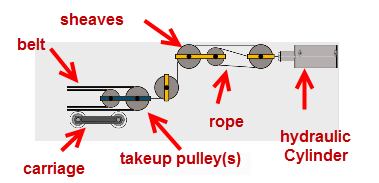|
<< Click to Display Table of Contents >> Hydraulic |
  
|
|
<< Click to Display Table of Contents >> Hydraulic |
  
|
Available in All versions
Available in All
Updated in v19
An automatic take-up method where the take-up pulley is mounted on a horizontal trolley attached to a wire rope guided by a series of sheaves to a hydraulically powered cylinder. The tension in the belt is generated by a hydraulic motor and pump. This option behaves very similar to the "Winch On/Off" meaning the motor/pump only turns on when the belt tension exceeds a high/low tension dead band (high and low pressure setting). The highest pressure setting is normally a system relief value. All belt tension in the system will fluctuate as the take-up tensions range between the high and low pressure settings.

This option requires little vertical space so is common in underground applications. Can take advantage of mechanical sheaves to increase tension or increase travel but is still fairly limited in conveyor length. If the dead band is set properly, the hydraulic motor/pump should not run very often but only adjust for permanent belt stretch. This option can provide some tensioning capacity even when power is lost but it is limited.
This device is generally slow and therefore is not always able to keep up with transient conditions in the belt during stopping/starting. Therefore it is common to increase the pressure on starting and allow much higher pressure during stopping. This generally increases system dynamics (increases all forces high and low) therefore advanced system design tools including flexible body transient analysis (dynamic analysis) is highly recommended when this option is chosen.
See Also: Fixed, Horizontal Gravity, Vertical Gravity, Winch Always On, Winch Off/On